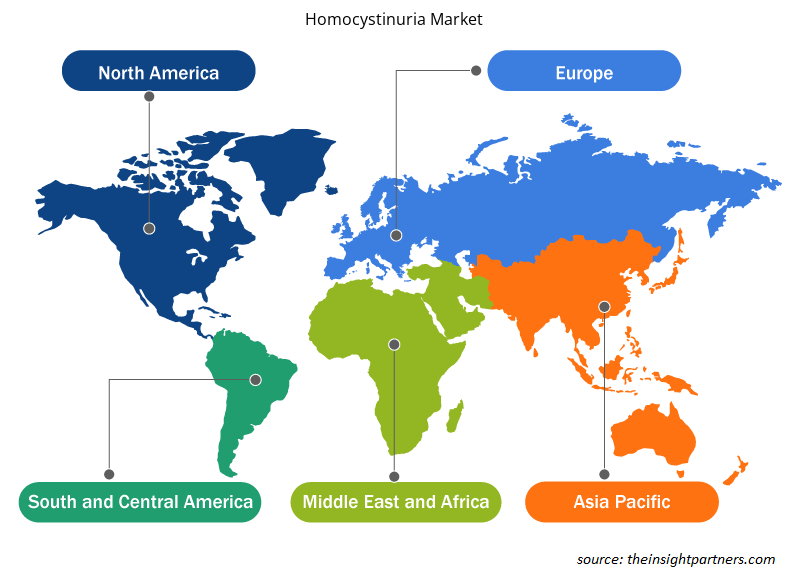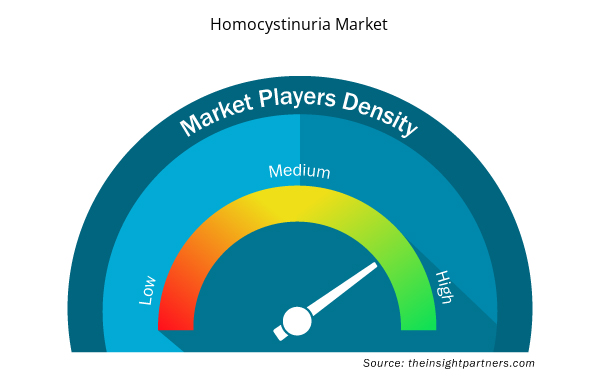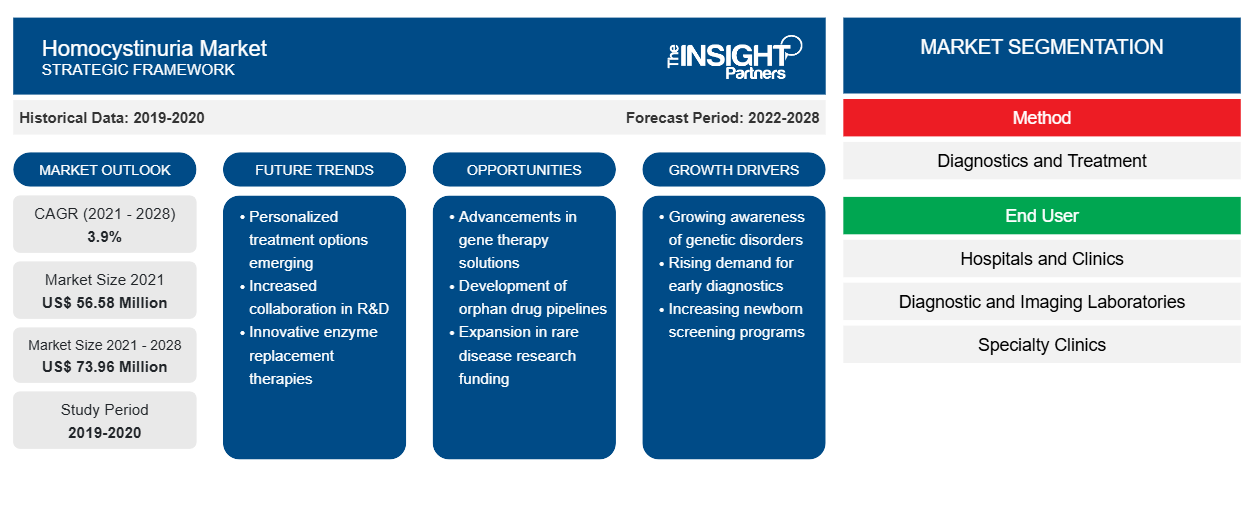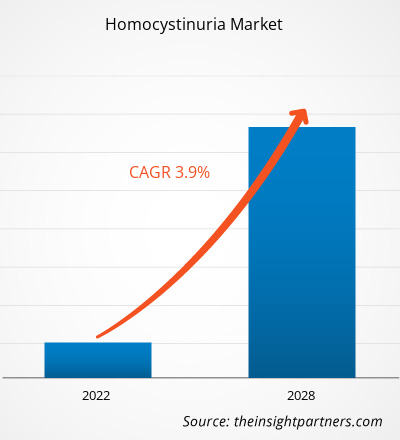Der Homocystinurie-Markt soll von 56,58 Millionen US-Dollar im Jahr 2021 auf 73,96 Millionen US-Dollar im Jahr 2028 anwachsen; für den Zeitraum 2021–2028 wird mit einer durchschnittlichen jährlichen Wachstumsrate von 3,9 % gerechnet.
Homocystinurie ist eine genetische Erkrankung, bei der der Körper nicht in der Lage ist, bestimmte Eiweißbausteine (Aminosäuren) richtig zu verdauen. Homocystinurie tritt in verschiedenen Formen auf, jede mit ihren eigenen Anzeichen und Symptomen sowie einer erblichen Ätiologie. Kurzsichtigkeit (Myopie), Verlagerung der Linse an der Vorderseite des Auges, ein höheres Risiko für unregelmäßige Blutgerinnung und brüchige Knochen, die zu Brüchen (Osteoporose) oder anderen Skelettanomalien neigen, sind die häufigsten Formen der Homocystinurie. Einige der betroffenen Menschen haben auch Entwicklungsverzögerungen und Lernschwierigkeiten.
Passen Sie diesen Bericht Ihren Anforderungen an
Sie erhalten kostenlos individuelle Anpassungen an jedem Bericht, einschließlich Teilen dieses Berichts oder einer Analyse auf Länderebene, eines Excel-Datenpakets sowie tolle Angebote und Rabatte für Start-ups und Universitäten.
- Holen Sie sich die wichtigsten Markttrends aus diesem Bericht.Dieses KOSTENLOSE Beispiel umfasst eine Datenanalyse von Markttrends bis hin zu Schätzungen und Prognosen.
Das Wachstum des Homocystinurie-Marktes wird auf den zunehmenden Mangel an Vitamin B6 und Vitamin B12 sowie die zunehmende Verbreitung vererbter Stoffwechselstörungen zurückgeführt. Das mangelnde Bewusstsein für verschiedene seltene Erkrankungen und vererbte Stoffwechselstörungen behindert jedoch das Marktwachstum.
Markteinblicke
Zunehmender Mangel an Vitamin B6 und Vitamin B12 treibt den Homocystinurie-Markt an
Die Zunahme von Vitamin-B6- und Vitamin-B12-Mangelmustern führt zu verschiedenen Erkrankungen wie Anämie, megaloblastischer Anämie, mikrozytischer Anämie und einigen Arten von Stoffwechselstörungen, was das Marktwachstum im Prognosezeitraum voraussichtlich ankurbeln wird. Da eine Vitamin-B6-Therapie als wirksame Therapie gegen Homocystinurie gilt, kann ein Mangel an diesem Vitamin den Zustand verschlimmern. Pyridoxin (Vitamin B6) wirkt als Cofaktor der Beta-Synthase und fungiert als Chaperon zur Stabilisierung mehrerer Missense-Mutationen. Einige Patienten mit Homocystinurie sprechen gut auf eine Pyridoxin-Therapie an, die hilft, den Homocysteinspiegel zu senken und so eine Linderung der Erkrankung zu erzielen. Daher gilt Vitamin B6 als unverzichtbar für die Behandlung von Homocystinurie, da nur eine begrenzte Anzahl von Behandlungen zur Heilung der Erkrankung zur Verfügung steht. Der Mangel dieses Enzyms führt zu Anämie und mikrozytischer Anämie. Die steigende Prävalenz von Anämie wird voraussichtlich das Marktwachstum im Prognosezeitraum ankurbeln. Laut der Weltgesundheitsorganisation sind beispielsweise über 1,62 Milliarden Menschen, also 24,8 % der Bevölkerung, von Anämie betroffen. Die Hauptursachen für Anämie sind falsche Ernährung und Mangel an Vitaminen wie B6, B9 und B12. Vor allem Vitamin-B6-Mangel ist eine der Hauptursachen für Anämie. Daher wird erwartet, dass eine Zunahme von Vitamin-B6-Mangelfällen und eine hohe Prävalenz von mit diesem Mangel verbundenen Erkrankungen das Marktwachstum im Prognosezeitraum unterstützen werden.
Methodenbasierte Erkenntnisse
Der globale Homocystinurie-Markt ist je nach Methode in Behandlung und Diagnostik unterteilt. Das Behandlungssegment hielt 2021 einen größeren Marktanteil. Darüber hinaus wird erwartet, dass dasselbe Segment im Prognosezeitraum aufgrund der etablierten Verwendung der Behandlung und der zunehmenden Forschung und Entwicklung neuer Behandlungen für Homocystinurie eine höhere CAGR auf dem Markt verzeichnet.
Regionale Einblicke in den Homocystinurie-Markt
Die regionalen Trends und Faktoren, die den Homocystinurie-Markt im Prognosezeitraum beeinflussen, wurden von den Analysten von Insight Partners ausführlich erläutert. In diesem Abschnitt werden auch die Homocystinurie-Marktsegmente und die Geografie in Nordamerika, Europa, im asiatisch-pazifischen Raum, im Nahen Osten und Afrika sowie in Süd- und Mittelamerika erörtert.

- Holen Sie sich die regionalspezifischen Daten für den Homocystinurie-Markt
Umfang des Homocystinurie-Marktberichts
| Berichtsattribut | Details |
|---|---|
| Marktgröße im Jahr 2021 | 56,58 Millionen US-Dollar |
| Marktgröße bis 2028 | 73,96 Millionen US-Dollar |
| Globale CAGR (2021 - 2028) | 3,9 % |
| Historische Daten | 2019-2020 |
| Prognosezeitraum | 2022–2028 |
| Abgedeckte Segmente | Nach Methode
|
| Abgedeckte Regionen und Länder | Nordamerika
|
| Marktführer und wichtige Unternehmensprofile |
|
Dichte der Marktteilnehmer im Bereich Homocystinurie: Auswirkungen auf die Geschäftsdynamik verstehen
Der Homocystinurie-Markt wächst rasant, angetrieben durch die steigende Endverbrauchernachfrage aufgrund von Faktoren wie sich entwickelnden Verbraucherpräferenzen, technologischen Fortschritten und einem größeren Bewusstsein für die Vorteile des Produkts. Mit steigender Nachfrage erweitern Unternehmen ihr Angebot, entwickeln Innovationen, um die Bedürfnisse der Verbraucher zu erfüllen, und nutzen neue Trends, was das Marktwachstum weiter ankurbelt.
Die Marktteilnehmerdichte bezieht sich auf die Verteilung der Firmen oder Unternehmen, die in einem bestimmten Markt oder einer bestimmten Branche tätig sind. Sie gibt an, wie viele Wettbewerber (Marktteilnehmer) in einem bestimmten Marktraum im Verhältnis zu seiner Größe oder seinem gesamten Marktwert präsent sind.
Die wichtigsten auf dem Homocystinurie-Markt tätigen Unternehmen sind:
- BASF SE
- HUAZHONG PHARMACEUTICAL
- Pfizer Inc.
- MYLAN NV
- Aeglea BioTherapeutics
Haftungsausschluss : Die oben aufgeführten Unternehmen sind nicht in einer bestimmten Reihenfolge aufgeführt.

- Erhalten Sie einen Überblick über die wichtigsten Akteure auf dem Homocystinurie-Markt
Endbenutzerbasierte Erkenntnisse
Der globale Homocystinurie-Markt ist nach Endverbrauchern segmentiert in Diagnostik- und Bildgebungslabore, Krankenhäuser und Kliniken, Fachkliniken sowie akademische und Forschungsinstitute. Im Jahr 2021 hielt das Segment der Diagnostik- und Bildgebungslabore den größten Marktanteil. Darüber hinaus wird erwartet, dass das Segment im Zeitraum 2021–2028 aufgrund der steigenden Zahl von Diagnosen vererbter Stoffwechselstörungen in Diagnostik- und Bildgebungslaboren die höchste durchschnittliche jährliche Wachstumsrate von 4,2 % verzeichnen wird.
Produkteinführungen und Zulassungen sind häufig von Unternehmen angewandte Strategien, um ihre globale Präsenz und ihr Produktportfolio zu erweitern. Darüber hinaus konzentrieren sich die Akteure auf dem Homocystinurie-Markt auf die Partnerschaftsstrategie, um ihren Kundenstamm zu vergrößern, was ihnen wiederum ermöglicht, ihren Markennamen weltweit aufrechtzuerhalten.
Der Bericht segmentiert den Homocystinurie-Markt wie folgt
Homocystinurie-Markt – nach Methode
- Behandlung
- Pyridoxin
- Betain
- Sonstiges
- Diagnose
- Genetische Tests
- Aminosäure-Screening-Test
- Leberenzymtest
- Sonstiges
Homocystinurie-Markt – nach Endverbraucher
- Krankenhäuser und Kliniken
- Diagnostik- und Bildgebungslabore
- Spezialkliniken
- Akademische und Forschungsinstitute
Homocystinurie-Markt – nach Geografie
- Nordamerika
- UNS
- Kanada
- Mexiko
- Europa
- Vereinigtes Königreich
- Deutschland
- Frankreich
- Italien
- Spanien
- Restliches Europa
- Asien-Pazifik
- China
- Japan
- Indien
- Australien
- Südkorea
- Restlicher Asien-Pazifik-Raum
- Naher Osten und Afrika
- Vereinigte Arabische Emirate
- Saudi-Arabien
- Südafrika
- Restlicher Naher Osten und Afrika
- Süd- und Mittelamerika
- Brasilien
- Argentinien
- Restliches Süd- und Mittelamerika
Firmenprofile
- BASF SE
- HUAZHONG PHARMACEUTICAL
- Pfizer Inc.
- MYLAN NV
- Aeglea BioTherapeutics
- Amino GMBH
- KAO Corporation
- DSM Corporation
- Verwaiste Technologien
- Fresenius Kabi AG
- Historische Analyse (2 Jahre), Basisjahr, Prognose (7 Jahre) mit CAGR
- PEST- und SWOT-Analyse
- Marktgröße Wert/Volumen – Global, Regional, Land
- Branche und Wettbewerbsumfeld
- Excel-Datensatz



Report Coverage
Revenue forecast, Company Analysis, Industry landscape, Growth factors, and Trends

Segment Covered
This text is related
to segments covered.

Regional Scope
North America, Europe, Asia Pacific, Middle East & Africa, South & Central America

Country Scope
This text is related
to country scope.
Häufig gestellte Fragen
The Asia Pacific region is expected to be the fastest-growing region among all other regions. The market in this region is expected to grow significantly in countries such as, China, Japan and India. The market is driven by increase in prevalence of inherited metabolic disorders, rise in government initiatives to manage rare diseases across the region along with increase in diagnostic tests across the region such as new born screening test etc. Therefore, the region holds huge potential for the homocystinuria market players to grow during the forecast period.
Homocystinuria is an inherited disorder in which the body is unable to process certain building blocks of proteins (amino acids) properly. There are multiple forms of homocystinuria, which are distinguished by their signs and symptoms and genetic cause. The most common form of homocystinuria is characterized by nearsightedness (myopia), dislocation of the lens at the front of the eye, an increased risk of abnormal blood clotting, and brittle bones that are prone to fracture (osteoporosis) or other skeletal abnormalities. Some affected individuals also have developmental delay and learning problems.
The growth of the Homocystinuria market is mainly attributed to factors such as the increasing prevalence of inherited metabolic disorders coupled with rise in vitamin B6 and Vitamin B12 deficiencies. However, the lack of awareness about various rare disorders and inherited metabolic disorders is hindering the market growth.
The global Homocystinuria market is expected to reach US$ 73,960.22 thousand by 2028 from US$ 56,589.20 thousand in 2021; it is estimated to grow at a CAGR of 3.9% during 2021-2028.
Emergence of human enzyme therapeutics and enzyme replacement therapy to treat rare disorders is one of the future trends of homocystinuria market. Enzyme replacement therapy and enzyme therapeutics is a type of novel drug therapy in which therapeutic enzymes are used to treat chronic and life-threatening diseases such as cancer, idiosyncratic disorders, and rare disorders. Furthermore, if an enzyme is not functioning properly in the body, then enzyme replacement therapy is used for replacing the enzyme that is deficient in the body. Enzymes have a predominant role in pharmaceutical industries and drug development as they treat various disorders. The advancements in the field of protein technology, recombinant DNA technology, enzyme immobilization, and nanotechnology have provided a solid platform for the use of enzymes in the treatment of various disorders.
Trends and growth analysis reports related to Life Sciences : READ MORE..
The List of Companies - Homocystinuria Market
- BASF SE
- HUAZHONG PHARMACEUTICAL
- Pfizer Inc.
- MYLAN N.V
- Aeglea BioTherapeutics
- Amino GMBH
- KAO Corporation
- DSM Corporation
- Orphan Technologies
- Fresenius Kabi AG.
The Insight Partners performs research in 4 major stages: Data Collection & Secondary Research, Primary Research, Data Analysis and Data Triangulation & Final Review.
- Data Collection and Secondary Research:
As a market research and consulting firm operating from a decade, we have published and advised several client across the globe. First step for any study will start with an assessment of currently available data and insights from existing reports. Further, historical and current market information is collected from Investor Presentations, Annual Reports, SEC Filings, etc., and other information related to company’s performance and market positioning are gathered from Paid Databases (Factiva, Hoovers, and Reuters) and various other publications available in public domain.
Several associations trade associates, technical forums, institutes, societies and organization are accessed to gain technical as well as market related insights through their publications such as research papers, blogs and press releases related to the studies are referred to get cues about the market. Further, white papers, journals, magazines, and other news articles published in last 3 years are scrutinized and analyzed to understand the current market trends.
- Primary Research:
The primarily interview analysis comprise of data obtained from industry participants interview and answers to survey questions gathered by in-house primary team.
For primary research, interviews are conducted with industry experts/CEOs/Marketing Managers/VPs/Subject Matter Experts from both demand and supply side to get a 360-degree view of the market. The primary team conducts several interviews based on the complexity of the markets to understand the various market trends and dynamics which makes research more credible and precise.
A typical research interview fulfils the following functions:
- Provides first-hand information on the market size, market trends, growth trends, competitive landscape, and outlook
- Validates and strengthens in-house secondary research findings
- Develops the analysis team’s expertise and market understanding
Primary research involves email interactions and telephone interviews for each market, category, segment, and sub-segment across geographies. The participants who typically take part in such a process include, but are not limited to:
- Industry participants: VPs, business development managers, market intelligence managers and national sales managers
- Outside experts: Valuation experts, research analysts and key opinion leaders specializing in the electronics and semiconductor industry.
Below is the breakup of our primary respondents by company, designation, and region:

Once we receive the confirmation from primary research sources or primary respondents, we finalize the base year market estimation and forecast the data as per the macroeconomic and microeconomic factors assessed during data collection.
- Data Analysis:
Once data is validated through both secondary as well as primary respondents, we finalize the market estimations by hypothesis formulation and factor analysis at regional and country level.
- Macro-Economic Factor Analysis:
We analyse macroeconomic indicators such the gross domestic product (GDP), increase in the demand for goods and services across industries, technological advancement, regional economic growth, governmental policies, the influence of COVID-19, PEST analysis, and other aspects. This analysis aids in setting benchmarks for various nations/regions and approximating market splits. Additionally, the general trend of the aforementioned components aid in determining the market's development possibilities.
- Country Level Data:
Various factors that are especially aligned to the country are taken into account to determine the market size for a certain area and country, including the presence of vendors, such as headquarters and offices, the country's GDP, demand patterns, and industry growth. To comprehend the market dynamics for the nation, a number of growth variables, inhibitors, application areas, and current market trends are researched. The aforementioned elements aid in determining the country's overall market's growth potential.
- Company Profile:
The “Table of Contents” is formulated by listing and analyzing more than 25 - 30 companies operating in the market ecosystem across geographies. However, we profile only 10 companies as a standard practice in our syndicate reports. These 10 companies comprise leading, emerging, and regional players. Nonetheless, our analysis is not restricted to the 10 listed companies, we also analyze other companies present in the market to develop a holistic view and understand the prevailing trends. The “Company Profiles” section in the report covers key facts, business description, products & services, financial information, SWOT analysis, and key developments. The financial information presented is extracted from the annual reports and official documents of the publicly listed companies. Upon collecting the information for the sections of respective companies, we verify them via various primary sources and then compile the data in respective company profiles. The company level information helps us in deriving the base number as well as in forecasting the market size.
- Developing Base Number:
Aggregation of sales statistics (2020-2022) and macro-economic factor, and other secondary and primary research insights are utilized to arrive at base number and related market shares for 2022. The data gaps are identified in this step and relevant market data is analyzed, collected from paid primary interviews or databases. On finalizing the base year market size, forecasts are developed on the basis of macro-economic, industry and market growth factors and company level analysis.
- Data Triangulation and Final Review:
The market findings and base year market size calculations are validated from supply as well as demand side. Demand side validations are based on macro-economic factor analysis and benchmarks for respective regions and countries. In case of supply side validations, revenues of major companies are estimated (in case not available) based on industry benchmark, approximate number of employees, product portfolio, and primary interviews revenues are gathered. Further revenue from target product/service segment is assessed to avoid overshooting of market statistics. In case of heavy deviations between supply and demand side values, all thes steps are repeated to achieve synchronization.
We follow an iterative model, wherein we share our research findings with Subject Matter Experts (SME’s) and Key Opinion Leaders (KOLs) until consensus view of the market is not formulated – this model negates any drastic deviation in the opinions of experts. Only validated and universally acceptable research findings are quoted in our reports.
We have important check points that we use to validate our research findings – which we call – data triangulation, where we validate the information, we generate from secondary sources with primary interviews and then we re-validate with our internal data bases and Subject matter experts. This comprehensive model enables us to deliver high quality, reliable data in shortest possible time.


 Holen Sie sich ein kostenloses Muster für diesen Bericht
Holen Sie sich ein kostenloses Muster für diesen Bericht